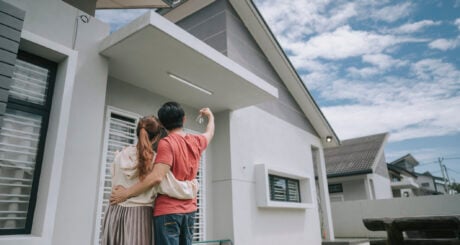Home ownership has always played a big part in the Australian dream, yet there is no one standard path to achieving it. In fact, there are many variables and external influences that can affect your journey along the way.
The real estate market, interest rates and housing availability are just a few factors outside your control.
What you can control, on the other hand, is making sure you get all the assistance you’re entitled to, and the First Home Owners Grant is key among these.
What is the First Home Owners Grant?
The First Home Owners Grant (FHOG) is an Australian Government initiative. The program began in 2000 and has changed over the years, but its mission remains the same: Help young Australians enter the property market as soon as possible.
The FHOG is a national scheme, but it varies from state to state and is primarily aimed at new home builders. For example, New South Wales and Victoria offer $10,000 toward buying or building a new home valued at up to $750,000, while that figure is $15,000 in South Australia.
How much is the First Home Owners Grant?
You may be entitled to $10,000 – $30,000 if you’re a first-home buyer.
How does the First Home Owners Grant work?
There are plenty of rules and requirements for eligibility. These include the following:
- The FHOG is only available for first-home buyers, meaning you cannot have previously owned a property.
- You can only receive the First Home Owner Grant once.
- You must be an Australian citizen or permanent resident who is 18 years or older.
- You must purchase the property under your name, not a company or trust.
- You must live in the property for a minimum of six to 12 months once it’s built. It’s designed for you to live in, not as an investment home.
- The maximum price ranges from $575,000 – $750,000.
- The property must be new or substantially renovated.
- In most applications, the home loan lender will lodge the FHOG on the individual’s behalf.
- The grant can be used as part of the down payment/deposit, which is what it’s intended for.
- You do not need to pay it back, and it’s not taxable.
You are only required to repay the grant if you move out of the property within the initial six-month period.
Requirements differ slightly from state to state, so before you apply, go directly to your state’s website for specific information, especially as to what your state classifies as a new home. In South Australia, for example, it includes a house, flat, unit, townhouse or apartment.
First Home Owners Grant eligibility
As long as you’re an Australian citizen or permanent resident aged 18 or over who plans to live in your new house and hasn’t previously owned a residential property, you can apply for the First Home Owner Grant. The grant is not means tested, so it doesn’t matter how much or how little you earn.
The First Home Owner Grant is not available for established houses. The grant for existing pre-inhabited homes ceased years ago. Additionally, if you previously owned a property but didn’t access the grant, you still won’t be eligible. You can’t apply if you inherited the property, either.
You also need to be wary of eligibility with regard to your spouse. For starters, check what the definition of a spouse is. In Victoria, for example, you’re not entitled to the First Home Owner Grant if your spouse previously received it.
Then, you should check for things such as the maximum property price for eligibility, residential requirements and receiving financial assistance from someone not eligible for the grant.
Most states have an eligibility checklist or online portal. If you’re unsure of anything, don’t hesitate to call your state’s contact centre and speak to a representative about your circumstances.
For ACT residents
The First Home Owner Grant in the Australian Capital Territory is called the Home Buyer Concession Scheme, and the eligibility requirements differ.
There’s a gross income cap, and all buyers (including their partners) must not have owned property in the past two years. The scheme allows ACT residents to bypass stamp duty on property purchases for new builds and established homes.
A word on substantial renovations
If most, or all, of the original house is removed or replaced, it’s deemed ‘substantially renovated’. You’re eligible for the grant if it’s the first time the house has been sold and lived in since the renovations were completed.
Updating only certain areas of the house, replacing a kitchen and bathroom or cosmetic improvements do not count as substantial improvements. Again, check with your local website to determine whether your structural changes satisfy the substantially renovated standard.
You don’t want to find yourself in a situation where you’re approved but later disqualified, as penalties and interest apply.
You’re eligible, so what’s next?
There may be some rigmarole involved in securing the First Home Owner Grant, but it’s well worth the effort. The FHOG has so far helped millions of Aussies get a home loan and fulfil their dreams of home ownership, and it’s there to help you, too.
How to apply
The application process differs from state to state.
Applications are made in one of two ways: through your home loan provider (approved agent) or directly through your state’s website. If you’re lodging the application yourself, you will require some additional documents.
The specific information required will depend on your situation and whether you’re buying or building.
Here are the types of documents you and your spouse will need to present:
ID documents:
- Birth certificate
- Passport
- Driver’s licence
- Medicare card
- Evidence of marriage, divorce, becoming widowed or being separated
New house documents:
- Contract of sale, signed by all parties
- Building permit
- Domestic building insurance certificate
- Certificate of occupancy
- Statement from the vendor confirming the house has never been lived in
- A transfer of land with a dealing number.
New build documents:
- Contract of build, signed by all parties
- First progress payment invoice for foundations laid
Owner builder documents:
- All major receipts for building costs
- Statutory Declaration stating the house is complete.
Give yourself adequate time to get these documents together, especially if you’re working with builders and other third parties. Most states have a cut-off date of 12 months after the settlement or completed construction to apply for the grant.
When you’ll get paid
When you get paid will depend on where you live, the type of property and how you apply.
For example, if you’re building a new home in Victoria and applied through an approved agent, the grant will be paid at the date of the first progressive payment.
If you did it via the website, your grant will only be considered after issuing the Certificate of Occupancy. If approved, the payment date will also be on the same date as the first progressive payment.
In both instances, the payment will be made as a direct deposit into a nominated bank account.
» MORE: Should you buy or rent?

How To Get A Home Loan
The home loan application process can be thorny. Here’s how to approach it.

What Are Mortgages and How Do They Work in Australia?
Home loans are not overly complicated, but having a rudimentary understanding of the fundamentals will give you a head start as you set out on the great Aussie home ownership journey.

How Much Can I Borrow for a Home Loan?
Instead of focusing on how much the bank will let you borrow, you should focus on what you can actually afford.

Fixed vs. Variable Interest Rate Home Loans
Fixed-rate home loans lock in a set interest rate, and variable-rate home loans have a rate that moves in line with the standard variable interest rate.

